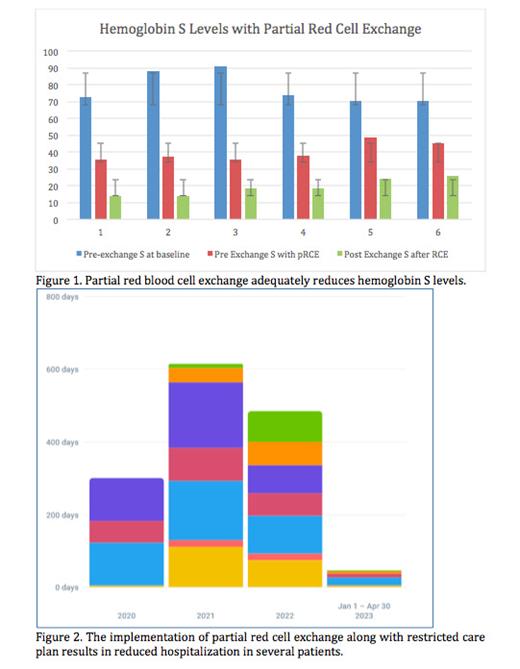Introduction:
Red cell exchange (RCE) is a therapeutic procedure that aims to reduce the number of sickle-shaped red blood cells in circulation and replace them with healthy donor cells. The use of red cell exchange in sickle cell disease (SCD) is primarily aimed at preventing or treating acute complications such as acute chest syndrome, stroke or priapism. However, in patients with inadequate disease control and associated frequent hospitalizations requiring parenteral opioids, we have proposed that prophylactic partial RCE (pRCE) be incorporated into the treatment plan. Implementation of pRCE with resulting limitation of parenteral opioid use may potentially reduce hospitalizations and achieve overall better disease control. Use of pRCE for disease control remains limited as it is labor intensive and requires copious amounts of blood which can be challenging especially in this era of COVID19 pandemic blood shortage. For this reason, we have utilized pRCE at our institution. Here we demonstrate that pRCE with four to five units of packed red blood cells (pRBCs) is equally effective in reducing hemoglobin S to levels below 40% and SCD related complications including VOCs and hospitalizations.
Methods and Results:
In our center, we identified six individuals with frequent hospitalizations and significant daily oral morphine equivalent requirements. These patients were then placed on a monthly pRCE protocol. Patients with variable genotypes were enrolled including HbSS, HbSC and HbSβthal +. Each patient underwent pRCE initially utilizing four units. Hemoglobin S level was closely monitored and if the target level of <40% was not reached with four units, the number was increased to five units. It is important to note that partial exchange was utilized only in patients whose indication for RCE was pain and frequent hospitalizations rather than history of CVA. In addition to pRCE, each patient was placed on a restricted care protocol that comprised of the administration of only home oral opioids during acute care visits. Prior to initiation of both pRCE and restricted care plan, patients were educated at length and during frequent clinic visits regarding the difference between chronic pain management and acute vaso-occlusive crisis.
As shown in Figure 1, partial exchange leads to adequate reduction of hemoglobin S levels immediately post exchange that remains suppressed over the four-week period to predominately below 40 percent. This reduction in hemoglobin S levels results in patient-reported improved sense of well-being and compliance with restricted care plans to limit acute care utilization and move SCD care to the outpatient setting. In fact, we saw a dramatic reduction in hospitalization among patients with sickle cell disease regardless of genotype, age and gender. As shown in Figure 2, for each patient placed on restricted care plan, acute care utilization was reduced compared to each patient's previous year's monthly admission rates.
Conclusion:
Prolonged uncontrolled SCD with frequent VOCs will undoubtedly result in high acute care utilization, high opioid requirements and risk of development of chronic pain with subsequent opioid induced hyperalgesia and opioid failure. Partial red cell exchange is an effective tool for addressing sickle cell disease complications and improving patient outcomes, particularly in patients with least disease control and highest acute care utilization.
Disclosures
Ershler:Novartis: Other: Advisory board; Responder's office, Speakers Bureau; Pharmacosmos: Other: Advisory board, Speakers Bureau; Pfizer: Other: Advisory board, Research Funding, Speakers Bureau; Global Blood Therapeutics: Other: Advisory board; Responder's office.


This feature is available to Subscribers Only
Sign In or Create an Account Close Modal